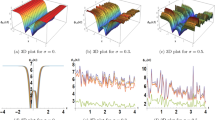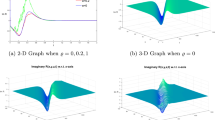Abstract
This article presents the modeling of spike trains in auditory nerve fiber (ANF) models with a one-memory self-exciting point process (SEPP) of the von Mises type. The ANF models were acoustically stimulated by a synaptic current of inner hair cells, or electrically stimulated by sinusoidally amplitude-modulated pulsatile waveforms. It has been shown that the parameters of one-memory SEPP of the von Mises type could be estimated by numerically maximizing the likelihood function from sample realizations of the spike trains in response to acoustic or electric stimulus. Furthermore, it was found that period histograms of the one-memory SEPP generated artificially on the basis of the estimated von Mises parameters agreed well with those of acoustic or electric stimulus, by performing the uniform-scores test. It implies that the waveforms of pulsatile electric stimuli should be selected such that the spike trains can be represented by one-memory SEPP of the von Mises type with appropriate parameters, efficiently carrying information to the cochlear implant user’s brain, like that in acoustic stimulation of the healthy ear. The findings presented in this paper may play an important role in determining optimal parameters of pulsatile electric stimuli by using one-memory SEPP of the von Mises type, and further in the design of better cochlear prostheses.








Similar content being viewed by others
References
Ashida G, Wagner H, Carr CE (2010) Processing of phase-locked spikes and periodic signals. In: Grun S, Rotter S (eds) Analysis parallel spike trains. Springer, New York, pp 59–74
Berry KJ II, Meister M (1998) Refractoriness and neural precision. J Neurosci 18:2200–2211
Bi Q (1989) A closed-form solution for removing the dead time effects from the poststimulus time histograms. J Acoust Soc Am 85:2504–2513
Carta JA, Bueno C, Ramírez P (2008) Statistical modelling of directional wind speeds using mixtures of von Mises distributions: case study. Energy Conver Manag 49:897–907
Cartee LA (2006) Spiral ganglion cell site of excitation ii: numerical model analysis. Hear Res 215:22–30
Clay JR, DeFelice LJ (1983) Relationship between membrane excitability and single channel open-close kinetics. Biophys J 42:151–157
Colburn HS, Carney LH, Heinz MG (2003) Quantifying the information in auditory-nerve responses for level discrimination. J Assoc Res Otolaryngol 4:294–311
Colombo J, Parkins CW (1987) A model of electrical excitation of the mammalian auditory-nerve neuron. Hear Res 31:287–312
Daley DJ, Vere-Jones D (2003) An introduction to the theory of point processes, 2nd edn. Springer, New York
Finley CC, Wilson BS, White MW (1990) Models of neural responsiveness to electrical stimulation. In: Miller JM, Spelman FA (eds) Cochlear implants: models of the electrically stimulated ear. Springer, New York, pp 55–96
Frijns JH, Mooij J, ten Kate JH (1994) A quantitative approach to modeling mammalian myelinated nerve fibers for electrical prosthesis design. IEEE Trans Biomed Eng 41:556–66
Galvin JJ, Fu Q-J (2005) Effects of stimulation rate, mode and level on modulation detection by cochlear implant users. J Assoc Res Otolaryngol 6:269–279
Galvin JJ, Fu Q-J (2009) Influence of stimulation rate and loudness growth on modulation detection and intensity discrimination in cochlear implant user. Hear Res 250:46–54
Gaumond RP, Molnar CE, Kim DO (1982) Stimulus and recovery dependence of cat cochlear nerve fiber spike discharge probability. J Neurophysiol 48:856–873
Gaumond RP, Kim DO, Molnar CE (1983) Response of cochlear nerve fibers to brief acoustic stimuli: role of discharge-history effects. J Acoust Soc Am 74:1392–1398
Goldberg JM, Brown PB (1969) Response of binaural neurons of dog superior olivary complex to dichotic tonal stimuli: some physiological mechanisms of sound localization. J Neurophysiol 32:613–636
Goldwyn JH, Shea-Brown E, Rubinstein JT (2010) Encoding and decoding amplitude-modulated cochlear implant stimuli—a point process analysis. J Comput Neurosci 28:405–424
Gray PR (1967) Conditional probability analyses of the spike activity of single neurons. Biophys J 7:759–777
Hawkes AG (1971a) Spectra and some self-exciting and mutually exciting point processes. Biometrika 58:83–90
Hawkes AG (1971b) Point spectra of some mutually exciting point processes. J R Stat Soc B 33:438–443
Heinz MG, Colburn HS, Carney LH (2001) Evaluating auditory performance limits: I. One-parameter discrimination using a computational model for the auditory nerve. Neural Comput 13:2273–2316
Hossain WA, Antic SD, Yang Y, Rasband MN, Morest DK (2005) Where is the spike generator of the cochlear nerve? Voltage-gated sodium channels in the mouse cochlea. J Neurosci 25:6857–6868
Hu W, Tian C, Li T, Yang M, Hou H, Shu Y (2009) Distinct contributions of Na v1.6 and Na v1.2 in action potential initiation and backpropagation. Nat Neurosci 12:996–1002
Imennov NS, Rubinstein JT (2009) Stochastic population model for electrical stimulation of the auditory nerve. IEEE Trans Biomed Eng 56:2493–2501
Johnson DH, Swami A (1983) The transmission of signals byauditory-nerve fiber discharge patterns. J Acoust Soc Am 74:493–501
Kumsa P, Mino H (2012) Effects of rates of spontaneous synaptic vesicle secretions in inner hair cells on information transmission in an auditory nerve fiber model. In: Proceedings of annual international conference of the IEEE engineering in medicine and biology society, pp 2993–2996
Li J, Young ED (1993) Discharge-rate dependence of refractory behavior of cat auditory nerve fibers. Hear Res 69:151–162
Mardia KV, Jupp PE (1999) Directional statistics. Wiley, Chichester
Mark KE, Miller MI (1992) Bayesian model selection and minimum description length estimation of auditory-nerve discharge rates. J Acoust Soc Am 91:989–1002
Matsuoka AJ, Rubinstein JT, Abbas PJ, Miller CA (2001) The effects of interpulse interval on stochastic properties of electrical stimulation: models and measurements. IEEE Trans Biomed Eng 48:416–424
McDermott HJ (2004) Music perception with cochlear implants: a review. Trends Amplif 8:49–82
McNeal DR (1976) Analysis of a model for excitation of myelinated nerve. IEEE Trans Biomed Eng 23:329–337
Miller MI (1985) Algorithm for removing recovery related distortion from auditory-nerve discharge patterns. J Acoust Soc Am 77:1452–1464 with errata (1986), ibid, 570
Mino H (2001) Parameter estimation of the intensity process of self-exciting point processes using the EM algorithm. IEEE Trans Inst Meas 50:658–664
Mino H (2007) Encoding of information into neural spike trains in an auditory nerve fiber model with electric stimuli in the presence of a pseudospontaneous activity. IEEE Trans Biomed Eng 54:360–369
Mino H (2016) Modeling of the spike trains in response to sinusoidally amplitude-modulated pulsatile electric stimuli in auditory nerve fiber models with inhomogeneous poisson process of von mises type. Int J Bioelectromagn 18:2–7
Mino H, Rubinstein JT (2006) Effects of neural refractoriness on spatio-temporal variability in spike initiations with electrical stimulation. IEEE Trans Neural Syst Rehabil Eng 14:273–280
Mino H, Rubinstein JT, White JA (2002) Comparison of computational algorithms for the simulation of action potentials with stochastic sodium channels. Ann Biomed Eng 30:578–587
Mino H, Rubinstein JT, Miller CA, Abbas PJ (2004) Effects of electrode-to-fiber distance on temporal neural response with electrical stimulation. IEEE Trans Biomed Eng 51:13–20
Mouritsen H, Ritz T (2005) Magnetoreception and its use in bird navigation. Curr Opin Neurobiol 15:406–414
Neher E, Stevens CF (1977) Conductance fluctuations and ionic pores in membranes. Ann Rev Biophys Bioeng 6:345–381
Ogata Y (1981) On Lewis’ simulation method for point processes. IEEE Trans Inf Theory IT–27:23–31
Ogata Y (1983) Likelihoodanalysis of point processes and its application to seismological data. Bull Int Stat Inst 2:954–961
Ogata Y, Katsura K (1986) Point-process models with linearly parametrized intensity for application to earthquake data. J Appl Prob 23:291–310
Ogata Y, Akaike H, Katsura K (1982) The application of linear intensity models to the investigation of causal relations between a point process and another stochastic process. Ann Inst Stat Math Part B 34:373–387
Ozaki T (1979) Maximum likelihood estimation of Hawkes’ self-exciting point processes. Ann Inst Stat Math Part B 31:145–155
Papoulis A (1985) Probability, random variables, and stochastic processes, 2nd edn. McGraw-Hill, Singapore
Press WH, Teukolsky SA, Vetterling WT, Flannery BP (1993) Numerical recipes in C: the art of scientific computing. Cambridge University Press, New York, pp 847–851
Rubinstein JT (1995) Threshold fluctuations in an N sodium channel model of the node of Ranvier. Biophys J 68:779–785
Siebert WM (1965) Some implications of the stochastic behavior of primary auditory neurons. Kybernetik 2:206–215
Siebert WM (1970) Frequency discrimination in the auditory system: place or periodicity mechanisms? Proc IEEE 58:723–730
Siebert WM, Gray PR (1963) Random process model for the firing pattern of single auditory neurons. MIT QPR 71:241–245
Snyder DL, Miller MI (1991) Random point processes in time and space, 2nd edn. Springer, New York
Tejani VD, Abbas PJ, Brown CJ (2017) Relationship between peripheral and psychophysical measures of amplitude modulation detection in cochlear implant users. Ear Hear 38:e268–e284
van Hemmen JL (2013) Vector strength after Goldberg, Brown, and von Mises: biological and mathematical perspectives. Biol Cybern 107:385–396
van Hemmen JL, Longtin A, Vollmayr AN (2011) Testing resonating vector strength: auditory system, electric fish, and noise. Chaos 21:047508
Woo J, Miller CA, Abbas PJ (2009) Simulation of the electrically stimulated cochlear neuron: modeling adaptation to trains of electric pulses. IEEE Trans Biomed Eng 56:1348–1359
Acknowledgements
This work was supported by JSPS KAKENHI Grant Nos. 15K01397 and 18K10692.
Author information
Authors and Affiliations
Corresponding author
Additional information
Communicated by Benjamin Lindner.
Publisher's Note
Springer Nature remains neutral with regard to jurisdictional claims in published maps and institutional affiliations.
Rights and permissions
About this article
Cite this article
Mino, H. Modeling of spike trains in auditory nerves with self-exciting point processes of the von Mises type. Biol Cybern 113, 347–356 (2019). https://doi.org/10.1007/s00422-019-00799-5
Received:
Accepted:
Published:
Issue Date:
DOI: https://doi.org/10.1007/s00422-019-00799-5




